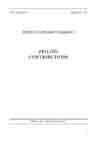Masakr ispred gradske tržnice Markale 28. augusta 1995. godine
The masaccre in front of the town marketplace Markale on the 28th of august 1995
Author(s): Merisa KarovićSubject(s): History
Published by: Institut za istoriju
Keywords: Markale; siege; Sarajevo; massacre; civilians; investigation; Inspection register; MUP RBiH; UNPROFOR; ICTY
Summary/Abstract: If we compare the investigation of the United Nations after the mass crimes committed against civilians before the 28thof August 1995 including the massacre of Markale from the 5thof February 1994, with the investigation after the crimes at Markale II, we can conclude that they perfectly fitted the political and military context, i.e. their results corresponded to the contemporary condition of the UNPROFOR forces on the field. All up to this massacre at Markale, the majority of UNPROFOR investigations were indefinite and vague thus (consciously) keeping open the question of responsibility of “both sides” for this crime. The phrase “the culprit was not identified”’, which was often used by United Nations, served as a perfect alibi for the intervention of NATO pact. Thereby, the avoidance of concrete action was an encouragement for the continuation of Sarajevo bombing. Nevertheless, in the case of the massacre at Markale from the 28thof August 1995, final conclusions of the UNPROFOR investigation clearly and undoubtedly claimed that the shells were fired from the position of “SRK”, from the direction of Trebević and Lukavica. However, the fact that official results of these investigations were published only after the “most vulnerable” elements of UNPROFOR members from the area of Goražde were evacuated and after all the necessary measures for their protection on other points were undertaken and that in the meantime the UNPROFOR commander in his statements to media spoke very indefinitely about who fired the mortar shells, says enough about the UNPROFOR tactics and providing of the motive for the manipulation which followed after the mass killings of civilians on other locations.Only after the mentioned conditions were fulfilled, were the perpetrators of this crime punished by bombing of the “VRS” positions by NATO, which eventually led to the end of the international armed conflict and the ending of the Sarajevo siege. But as the result of this late reaction are, among other things, the mass killings of civilians by shelling, sniping and aerial bombing from the posts of “SRK”, committed on other 223 locations in the besieged part of the city. Despite the conclusion of the ICTY Trial Chamber in the case of Dragomir Milošević that the shell was “beyond any reasonable doubt” fired from the positions of “SRK”, the commander of this corps was freed from the charge of shelling Markale because at the time of execution of his order, he was receiving medical treatment in Belgrade. It is a terrible fact that neither his substitute nor any other commander from lower levels, nor direct executioners were tried and that there is no court verdict that convicts this crime
Journal: Prilozi
- Issue Year: 2013
- Issue No: 42
- Page Range: 151-185
- Page Count: 35
- Language: Bosnian

